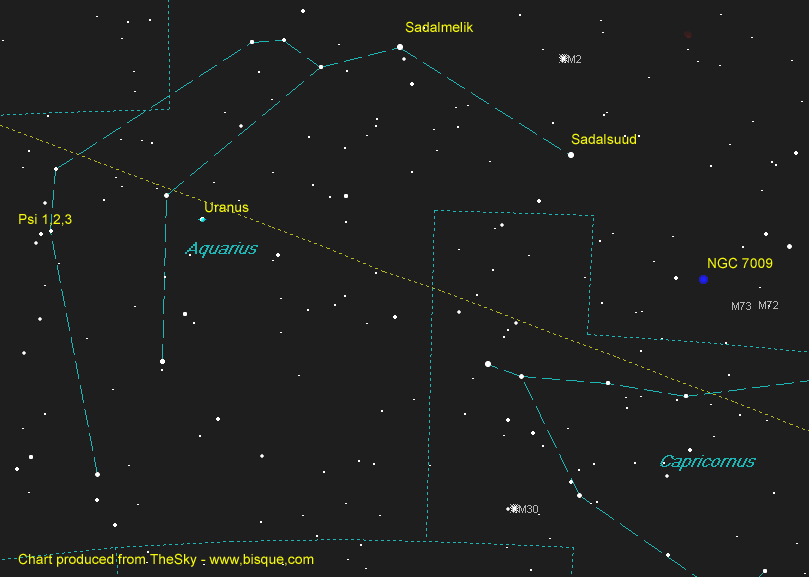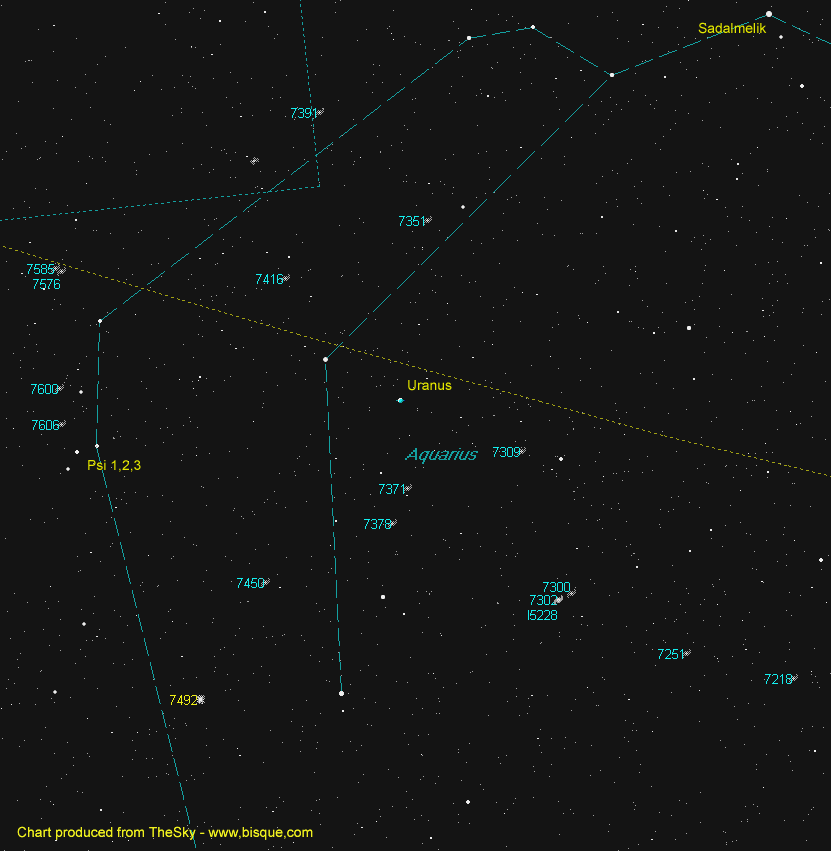Aquarius the Water Bearer
The constellation Aquarius is well placed this month and is at its highest point in the sky at about 11 p.m. locally. This is a fairly large constellation with almost 1,000 square degrees in size thus making it 10th in overall size. The brightest star (alpha) is named Sadamelik. It is a Sun-like G2 star located 523 light-years away with a magnitude of 2.95; it rivals the next brightest star named Sadalsuud (beta) in brightness and is about the same distance. It is believed these two suns, as well as the star Enif located in the constellation Pegasus, were formed together like the Pleiades cluster but in a looser association.

At the upper right side of the constellation, locate NGC 7009 - the Saturn Nebula. This is the only planetary nebula located in Aquarius. Located some 4,200 light-years away, this 8th nebula takes on the appearance of the ringed planet. Appearing greenish in colour, even a small telescope will show its magnitude 12 central hot dwarf star. The estimated surface temperature of this 20 km wide dwarf is 55,000 degrees almost 10 times the temperature of our Sun.
Not far from the Saturn Nebula are M73 and M72. First is M73 which appears to be a four-star asterism to which Charles Messier described as "Cluster of three or four small stars, which resembles a nebula at first glance, containing very little nebulosity”. This 9th magnitude group is only 2,500 light-years away. To the right of M73 is the globular cluster M72 which is a tad fainter than M73 but 22 times farther from us and past the Galactic Centre. At its time of discovery in 1780, it was first believed to be a nebula and not a star cluster.

Another challenge is the globular cluster NGC 7492. It is an extremely distance target to which older large telescopes resolved it as a magnitude 11.5 comet and not a cluster. There are numerous galaxies within the borders of Aquarius. The brightest and easiest galaxy to locate is NGC 7606. At a distance of 108 million light-years, this galaxy is listed as magnitude 10.8 and can be found less than a degree north of the arc of three stars catalogued as Psi 1, 2 and 3. NGC 7492 is very elongated and possesses tight spiral arms. The planet Uranus is still in Aquarius and will be until May 2022. It then ventures into Pisces for a short period until it retrogrades back to Aquarius.

With Jupiter now lost in the solar glare and becoming a morning object, Mercury can be seen battling the dawn and sinking back to the horizon. On October 11, Mercury will be to the left of Jupiter. Low in the southwest, we see brilliant Venus in the twilight. A few digital moments are Oct 3 when the 8% crescent moon with the Da Vinci glow or earthshine, will be five degrees north of Venus. Then on the 23rd, it can be seen north of the globular cluster M30 in the constellation Scorpius. Four nights later Venus lines up with the star Antares (553 light-years away) at the bottom and Saturn at the top whose light now takes 87 minutes to reach us. Venus is currently 11 light minutes away.
The mighty winter sky is now rising with Orion up at midnight local time at the beginning of the month. And speaking of the mighty hunter, the Orionids peak 5 hours UT on the 21st. Because of the pesky gibbous moon, the hourly rate will be reduced to 10 – 20 meteors per hour. This shower is produced by Halley’s Comet which is also responsible for the Eta Aquarids in May. These fast-moving sand-sized particles strike the upper atmosphere at 66 km/sec, about 100 km high. For the first two weeks of October, look for the zodiacal light rising up from the eastern horizon before the break of dawn. This is the dusty remains of our interplanetary solar system reflecting from sunlight. October’s new moons occur on the 1st (lunation 1160) the 30th (lunation 1161). The full Hunter’s Moon occurs on Oct 16.
Until next month, clear skies everyone.
Twitter: @astroeducator
